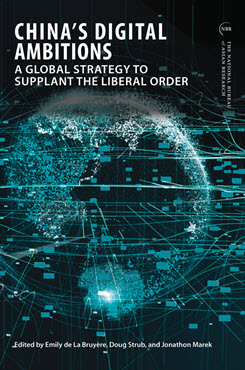Crafting a Competitive Response
A Framework for Countering China’s Digital Ambitions
This chapter argues that as the Chinese Communist Party (CCP) makes the world increasingly illiberal through its efforts to control the global digital ecosystem, democracies should work together to establish platforms, systems, and infrastructure that reinforce liberal democratic values.
Download the full report in: French | Japanese | Korean.
Download the Executive Brief in: French | Japanese | Korean.
The project also features an interactive data tool for visualizing the global reach of China’s digital ambitions and the relationships between different forms of Chinese digital influence: Access the data tool here.
EXECUTIVE SUMMARY
MAIN ARGUMENT
The People’s Republic of China (PRC) and the corporate entities that the CCP increasingly controls are building digital platforms and infrastructure that risk becoming the “operating system” for a new, illiberal international order—and, in the process, cementing the CCP’s leadership over the fourth industrial revolution. The characteristics of this operating system reflect the choices and interests of the CCP. To achieve this, the party has launched an ambitious campaign to develop, export, set the rules of, and maintain control over both the physical and digital networks of the fourth industrial revolution. This would enable its creation of a system that makes the world safe for authoritarianism by legitimizing the party’s governance model, cementing an advantage for Chinese commercial and military actors, and, more broadly, locking in the party’s control over information. This presents a challenge to the incumbent international system and the freedoms, opportunities, and security that it undergirds, while also weakening liberal societies’ multilateral leadership over the global system. Countries concerned with the PRC’s digital rise must actively compete with Beijing for the architecture of the fourth industrial revolution and construct a positive alternative that privileges liberal democracies while undermining authoritarian regimes.
POLICY IMPLICATIONS
- Democratic policymakers and business leaders must accept that Beijing’s alternative system and its challenge to the global architecture are a present reality, not a future condition. Recognizing this truth is the most important step in designing and perpetuating government policies and business models that will succeed in the world as it is rather than what some desire it to be.
- Liberal democracies and like-minded countries need to develop a “common operating picture” to better understand the technological, industrial, and commercial systems that shape the digital ecosystem.
- An effective response to China’s digital strategy requires efforts to ensure that the digital ecosystem of the future reinforces democratic values and the rule of law.
Matt Turpin is a Visiting Fellow at the Hoover Institution specializing in U.S. policy toward the People’s Republic of China, economic statecraft, and technology innovation. Formerly, he was the China director at the U.S. National Security Council.



 Identifying and Countering China’s Global Digital Strategy (Paris)
Identifying and Countering China’s Global Digital Strategy (Paris)

